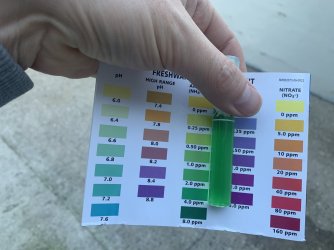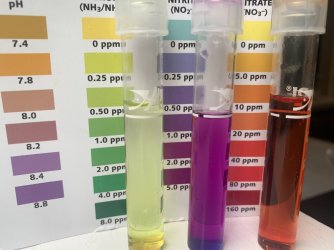You need to feed the ammonia eaters while waiting for the nitrite eaters to grow. The old way of fishless cycling said to add 3 ppm every time ammonia dropped to zero, but this made so much nitrite that the cycle stalled. TwoTankAmin did a lot of research in the literature and realised that yes, you do need to add ammonia to feed the nitrite eaters but that the amount could be kept to a minimum so nitrite never got too high. So he wrote the method on here so that if followed exactly the ammonia eaters would thrive but nitrite wouldn't stall the cycle.
Add 3 ppm ammonia. It's usually the same as was added to start the cycle, but in your case you added too much at the start (post #57). You added 5 ml and the reading was off the top of the scale. After changing half the water the level was OK. So try adding 2.5 ml ammonia, wait half an hour for it to mix in then test for ammonia to see what the level is. if it's 3 ppm-ish that's good. If it's too low, add a bit more. Make a note of how much you add altogether, whether that 2.5 ml is enough or whether you add a bit more - you need to know because you will add more ammonia later on.
This stage is the tricky one to explain. Once you've got the ammonia level right, test every two days. Ammonia is the important one now because you need to wait until you have zero ammonia. When you get that zero ammonia, wait 2 days and test again. If that ammonia reading is also zero you are ready for the next stage. But you need to wait until you have zero ammonia and then zero ammonia again 2 days later.
Add 3 ppm ammonia. It's usually the same as was added to start the cycle, but in your case you added too much at the start (post #57). You added 5 ml and the reading was off the top of the scale. After changing half the water the level was OK. So try adding 2.5 ml ammonia, wait half an hour for it to mix in then test for ammonia to see what the level is. if it's 3 ppm-ish that's good. If it's too low, add a bit more. Make a note of how much you add altogether, whether that 2.5 ml is enough or whether you add a bit more - you need to know because you will add more ammonia later on.
This stage is the tricky one to explain. Once you've got the ammonia level right, test every two days. Ammonia is the important one now because you need to wait until you have zero ammonia. When you get that zero ammonia, wait 2 days and test again. If that ammonia reading is also zero you are ready for the next stage. But you need to wait until you have zero ammonia and then zero ammonia again 2 days later.



